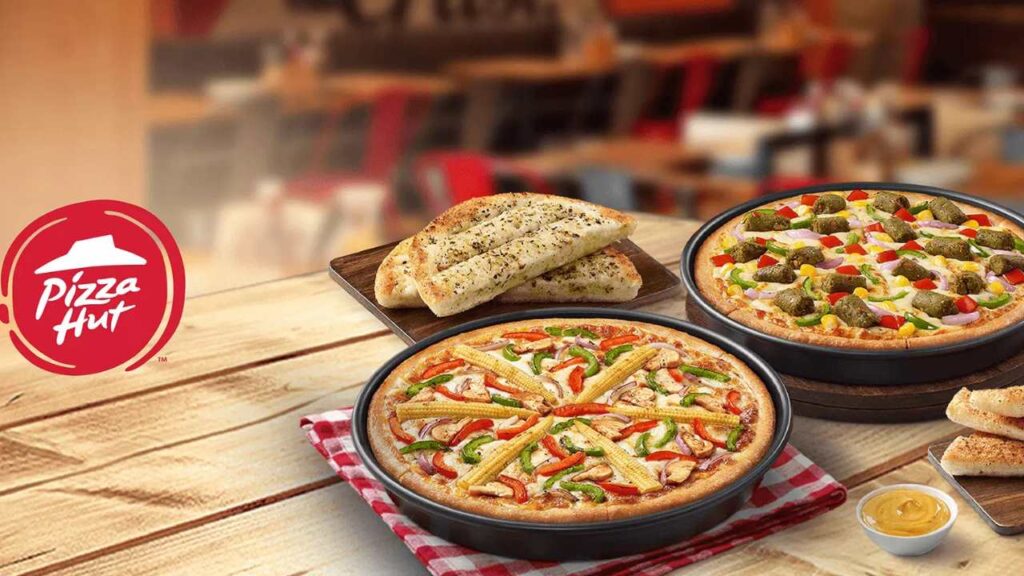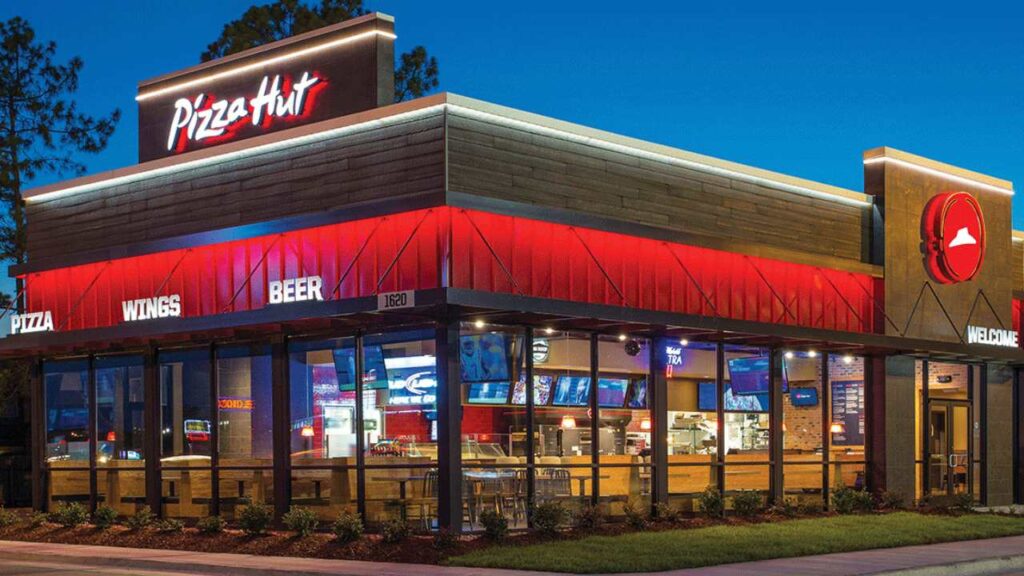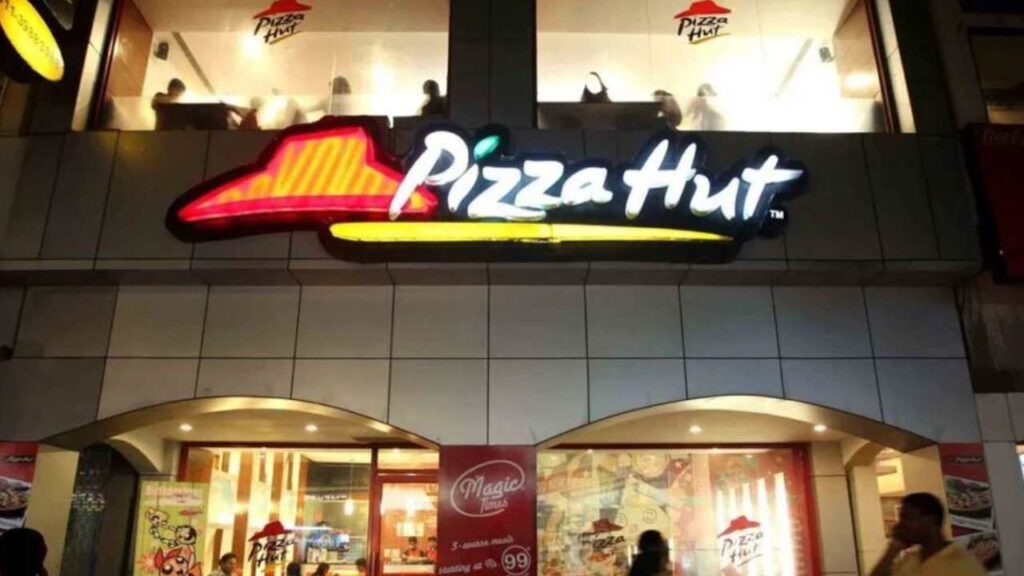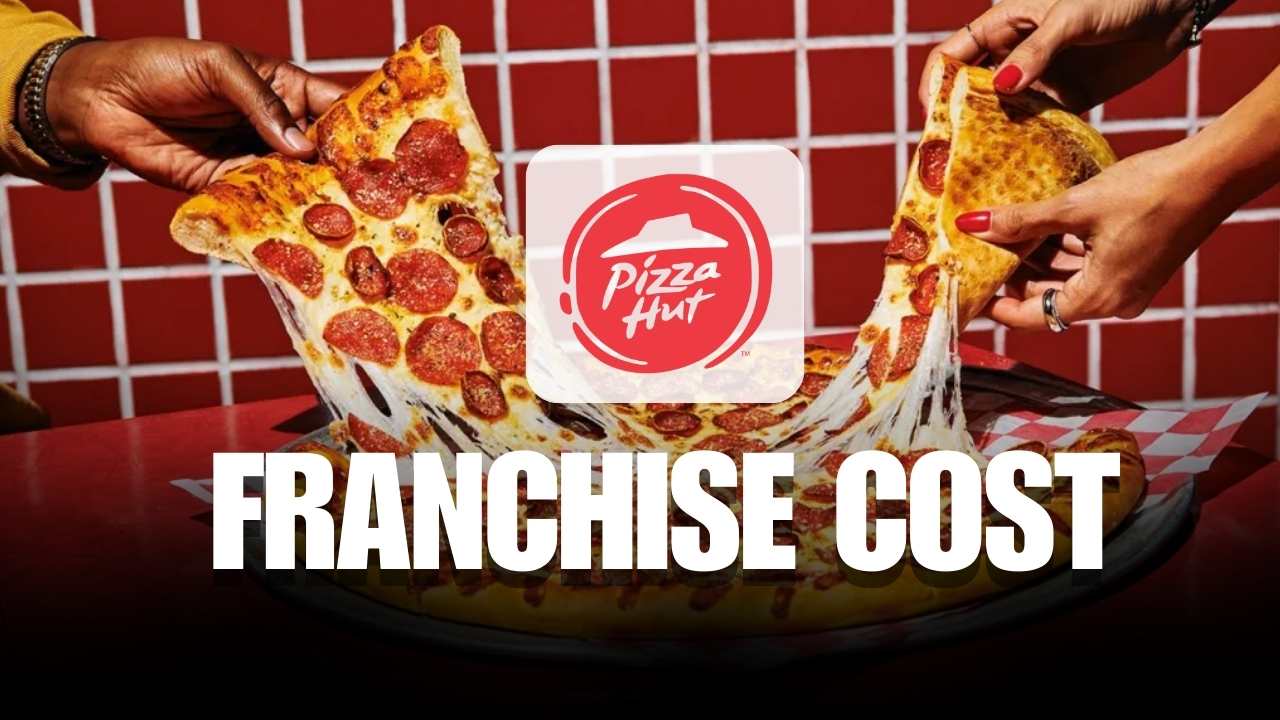The food industry in India has seen an exciting change in the past few years, with the food service market expected to reach $95.75 billion by 2025, growing at an annual rate of 10.3%. Among various segments, the quick-service restaurant (QSR) sector is witnessing a surge in popularity, driven by young urban consumers who prefer fast and convenient food options. The online food delivery market, which was valued at ₹400 billion in 2020, is also projected to double in size to ₹960 billion by 2025, making it a key driver of growth in the industry.
Within this booming landscape, the pizza franchise business has shown remarkable growth. Among all foreign pizza chains, Pizza Hut stands out as one of the most easily recognizable and favored brands nationwide. Entrepreneurs looking to venture into the food business see franchising as a lucrative opportunity, especially with the rising demand for quick and quality dining experiences.
In this article, we will discuss the Pizza Hut franchise cost in India, including all the steps required to establish a franchise. Moreover, we will explore why the pizza business is growing in India, why Pizza Hut is a strong franchise option, and address key questions about profitability, support, and operations.
About Pizza Hut

This Brand is a multinational pizza fast food that has grown to be among the largest and well-known brands in the world. Originally established in 1958 it has expanded into an international franchise attracting a customer base owing to its specialty in its various flavors, various crusts, and dining atmosphere. It opened the market of India in 1996 and at present it successfully operates more than 500 outlets all over India and it is a well-known brand.
The brand’s menu consists of different pizzas such as Pan Pizza, thin crust pizza and stuffed crust pizzas. In addition to pizzas, it deals in complementary foods including pasta, garlic breads and other related delights making it a take away fast foods joint.
Explore How to start a small business at home.
Why Choose a Pizza Hut Franchise?
Global Brand Recognition
Pizza Hut is one of the world’s most significant and renowned pizza chains, and it has firmly established itself in the Indian market. Founded in 1958, the brand expanded exponentially to over 19,000 outlets across more than 100 countries. Pizza Hut dominates the Quick Service Restaurant (QSR) segment in India, with over 500 stores and aggressive expansion plans. This global presence ensures immediate customer trust, reducing the need for extensive brand marketing efforts.
Proven Business Model
Newcomers to the industry benefit from Pizza Hut’s well-established and risk-mitigated franchise system. With decades of experience, the franchise model has proven to be a jackpot in profitability, offering 40%- 50% gross profit margins and 15%- 20% net profit margins after deducting expenses. Entrepreneurs stepping into this business can leverage the brand’s structured operations and business expertise, ensuring smoother entry and long-term success.
Comprehensive Support
Pizza Hut provides end-to-end franchise support, including training, marketing, and operational assistance. This ensures franchise owners are fully equipped to run the business efficiently while maintaining brand quality and service standards.
High Consumer Demand
With the growing popularity of fast food and a rising customer base, especially in urban areas, franchisees benefit from a steady influx of dine-in, takeout, and delivery customers. Pizza Hut continues to capture India’s booming QSR market by introducing fresh product menus, digital innovations, and superior service experiences. The brand is set to grow 15% in the coming years, further reinforcing its stronghold in the industry.
Multiple Business Formats
Pizza Hut offers various business formats, including full-service restaurants, small kiosks, and delivery-based models. This flexibility allows entrepreneurs to choose an investment level that aligns with market demand and financial capacity.
A Rare Investment Opportunity
Backed by Yum! Pizza Hut Brands provides entrepreneurs a rare chance to invest in a globally successful and high-growth food franchise. With strategic expansion, high profitability, and strong market positioning, this is an ideal investment for those looking to establish themselves in India’s thriving food service industry.
Pizza Hut Franchise Cost in India

Pizza Hut Franchise Cost in India: Full Detail
To establish a Pizza Hut franchise you need significant capital that includes paying the franchise fee and acquiring real estate properties and equipment and establishing working capital. The following provides a breakdown of these costs.
1. Initial Franchise Fee
A Pizza Hut franchise applicant needs to pay an initial franchise cost. Franchise owners pay an initial payment to obtain Pizza Hut brand rights while getting help from the corporate entity.
- Franchise Fee: The initial franchise fee for Pizza Hut operates between ₹25–₹40 lakh depending on the selected store location and format.
- License Term: Typically 10 years, renewable.
The brand licensing together with initial training and launch phase support is included in this fee.
2. Real Estate and Construction Costs
A Pizza Hut outlet requires a location which will determine its eventual success. The overall investment for real estate and construction depends on the city location as well as the chosen store format and property ownership status.
- Store Space Requirement: 1,000–1,500 sq. ft. (for a dine-in restaurant), 500–800 sq. ft. (for takeaway/delivery models).
- Rental Costs: The minimum required space for Pizza Hut restaurants ranges between 1,000 to 1,500 square feet for dine-in locations while takeaway outlets require 500 to 800 square feet.
- Construction and Interior Setup: ₹50 lakh–₹1 crore.
The construction expenses encompass flooring, kitchen planning, dining area arrangement and signs alongside lighting and branding design elements.
3. Equipment and Inventory Costs
A Pizza Hut outlet requires high-quality kitchen equipment together with furniture and ingredients for its initial stock to operate smoothly.
- Kitchen Equipment (ovens, refrigerators, dough mixers, etc.): ₹30–₹50 lakh.
- Furniture and Fixtures: ₹10–₹15 lakh.
- Initial Inventory (cheese, dough, sauces, toppings, beverages, etc.): ₹5–₹10 lakh.
4. Training and Opening Costs
All Pizza Hut franchisees gain access to thorough training and staff training programs for sustaining brand identity standards. The training curriculum includes sections about customer service together with food preparation and operational standard requirements.
- Training Cost: The expense for training falls under the franchise fee.
- Grand Opening Expenses: The cost range for opening expenses during a grand opening amounts to ₹5–₹10 lakh which includes marketing expenditures alongside discount promotions along with launch events.
5. Working Capital
Successful franchise operation relies on enough working capital to handle regular business needs and salary payments for staff members as well as rent requirements and financial stability.
- Recommended Working Capital: ₹15–₹25 lakh (for the first 6–12 months).
6. Royalty and Marketing Fees
Ongoing fees to Pizza Hut are a requirement of the franchise agreement for franchisees.
- Royalty Fee: 6% of monthly gross sales.
- Marketing Fee: The franchise agreement requires both marketing payments and royalty fees based on 4% and 6% of your monthly sales revenue respectively.
Factors Affecting the Pizza Hut Franchise Cost
Many factors can lead to variations in the total investment that an investor will have to make in a Pizza Hut franchise:
- Location and Real Estate Cost: The rent or purchase price of any property will depend on the city, zone, and customer traffic. Prime locations in metro cities such as Mumbai, Delhi, and Bangalore have very high rent somewhere in the range of ₹1.5-₹5 lakh per month for dine-in outlets, while their counterparts in smaller towns or suburbia will have relatively reasonable rent.
- Store Format and Size: Pizza Hut has formats including dine-in, takeaway and delivery, and express. A dine-in outlet needs more areas of about 1,000-1,500 square feet, which are costlier due to seating arrangements, while a delivery-oriented store with about 500-800 square feet would save on real estate and business setup costs.
- Construction and Interiors: Giant sums are to be invested in renovation and interior works in accordance with Pizza Hut’s brand standards. Costs may vary between ₹50 lakh and ₹1 crore, based on location and store size, for flooring, furniture, lighting, branding, and kitchen layouts.
- Equipment and Inventory Cost: The kitchens contain ovens, dough mixers, refrigerators, and storage units; therefore high-quality branded equipment will cost an investor ₹30-50 lakh, whereas furniture and starting inventory consisting of cheese, sauces, toppings, and beverages will amount to an additional ₹15 lakh.
- Royalty and Marketing Fees: Franchisees normally pay Pizza Hut a 6 percent sales royalty every month and this conventionally amounts to a 4 percent marketing fee in support of co-branding and promotions. The greater the sales volume, the higher the royalty amounts.
- Labor and Operational Costs: Labor wages differ in each city or practice area, which in turn influences the wage of that particular person. Local licenses, food safety compliance, and supply chain costs will also account for operational expenses. Having working capital of ₹15-₹25 lakh should ensure that the business is run smoothly.
Space and Location Requirements
The most important asset in operating a thriving Pizza Hut franchise business is choosing the right place. The space and location requirements for a franchise vary depending on the type of outlet you want to open:
- Dine-in Restaurant: To start a dine-in fully fledged restaurant, you will require a location of at least 1,000 – 1,500sqft in a strategic location such as a shopping center or a busy commercial area.
- Delivery Outlet: If you plan on operating a delivery only store, you may require a much smaller space of about between 500 and 700 square meters in an area that can easily be accessed by delivery vehicles.
- Express Outlet: Pizza Hut Express are also somewhat less, and they often occupy a small area in food courts or such busy places as airports. These need about 300 – 500 square feet.
Here’s a table summarising the space and location requirements for each outlet type:
| Franchise Type | Space Required (sq ft) | Preferred Location |
| Dine-in Restaurant | 1,000 – 1,500 | High-footfall areas (malls, busy streets) |
| Delivery Outlet | 500 – 700 | Areas with delivery vehicle access |
| Express Outlet | 300 – 500 | Food courts, airports, high-traffic areas |
Training and Support from Pizza Hut
It is able to provide extensive training and coaching to its franchisees down to this present time. Here’s what you can expect:
- Initial Training: When you open your outlet, Brand has detailed training programs to make sure that you and your employees run the business efficiently. This training encompasses all aspects of running a restaurant, it includes the food handling, customer relations, and many others.
- Operational Support: After the establishment of the outlet, Pizza Hut’s support is not limited to the sale of its products, but it gives operational assistance, product information and management advice on how to increase productivity and profitability of the outlet.
- Marketing Support: They coordinate national marketing Communications, but franchisee operations also get support on how they can market locally to create traffic.
- Supply Chain Management: This brand has a good supply chain solution where you are supplied with the appropriate raw materials and ingredients at the right time, hence quality.
- Technology Support: The brand provides technical support for POS terminals, online ordering services, and all forms of technology that improve customer relations and business performance.
Steps to Start a Pizza Hut Franchise

The process of starting a its franchise is a step by step process from the application to the actual opening of the Store. Here’s an outline of the process:
- Research: First of all, you need to start your research on the Pizza Hut franchise cost in India; the requirements for the franchise and the overall pizza market.
- Submit Application: If you are sure about proceeding further then fill in an application through the official franchising site or get in touch with the franchising department.
- Initial Discussions: When it is reviewed, you will be able to talk to the franchising team, and appreciate the operational model, costs, and other aspects.
- Site Selection: Consult the their representatives and assist with selection of a perfect location that meets all space and visibility requirements.
- Legal Agreements: Execute a franchise agreement, where essential details of the working relationship will be described in details such as the amount to be paid in form of royalty, the period the franchisee will operate under the contract, other legalities will be discussed and agreed on.
- Store Setup: Equip the outlet for instance by designing the interior, installing kitchens and recruiting employees. It will give you directions as you go through the setup process.
- Training: Ensure you and your team have completed any training which Brand has deemed necessary for you all to do.
- Grand Opening: After the setup and training, this part seeks to outline different steps on how to go ahead and establish your franchise. If they will allow it, This brand may help in spreading the word about your grand launch.
Profit Margins and Return on Investment (ROI)
This simply means that the amount of return on investment that can be obtained from a Pizza Hut franchise cost in India depends on factors including the business location, traffic and general performance. For the most part, this franchise can anticipate earning a gross profit of 10 – 15% of the gross sales. Despite this, such margins may differ based on the market demand of the location, competition and delivery services. In fact, franchises operating in busy locations or with an extensive delivery system demonstrate better performance.
On average, franchisees can expect to get an ROI in 3 to 5 years depending with the way they handle their operations and demand. New franchise networks operating in central business districts or large cities may realize their ROI more quickly, probably within the range set above. Furthermore, the flexibility involved in the management of the digital delivery demands and the management of promotion initiatives determines the profit margins with regards to the ability to achieve ROI within desirable time horizons.
| Product Type | Profit Margin (%) | Expected ROI Timeline |
| Dine-In | 10% – 12% | 4 – 5 years |
| Takeaway | 10% – 13% | 3 – 5 years |
| Delivery | 12% – 15% | 3 – 4 years |
Is Pizza Hut a Profitable Business?
Pizza Hut has made considerable brand inroads in India, thus providing an opportunity for a lucrative business. However, profitability depends on the location, efficiency of operations, and demand in the market.
1. Revenue Potential
India’s Pizza Hut outlets can rake in phenomenal sales every month. Major sources of revenue include:
- On premise dining
- Takeout and delivery orders
- Corporate and bulk orders
Estimated Monthly Revenue: ₹15 lakh – ₹50 lakh (based on location and format).
2. Profit Margins
- Gross Profit Margin: 40%–50%.
- Net Profit Margin: 15%–20% after deducting rent, salaries, royalty fees, and other expenses.
3. Market Growth
The fast food segment in India is actually going faster as upscale life and an evolving consumer appetite. According to industry reports:
- The fast food market in India would be expected to grow at a CAGR of 15% over the next five years.
- Pizza Hut is aggressively expanding under the wing of Yum! Brands and has thus become a solid player in the competing market space.
Success Factors for a Pizza Hut Franchise
These are a few of the important things a franchisee should take care of to be most profitable in the long run:
- Strategic Location Choice: Finding a location with a high customer footfall near densely populated areas, workplaces, or malls increases traffic.
- Strong Marketing and Branding: Digital marketing coupled with local advertisement promotions can drive sales and attract customers.
- Quality and Customer Service Delivery: Keeping up the quality and providing excellent customer service are major items in keeping the customers and making them loyal to the brand.
- Managing the Cost Efficiently: Largely contributes to increased margins by keeping operational expenses to a minimum, optimizing the supply chain logistics, and lowering wastes.
- Capitalizing on Online and Delivery Platforms: Hooking up with these food delivery applications like Swiggy and Zomato widens its reach and boosts sales, especially in urban areas.
- Training Staff without Let Up: The training also gives employees orientation in high service standards and the effective following up of brand guidelines.
Pros & Cons of Pizza Hut Franchise
Pros:
- Established Brand: By being internationally recognized, this brand has customer loyalty and this favors the franchisees by creating easy market penetration.
- Proven Business Model: Regarding the concept of operation, this business model is already successful and optimised in this brand meaning that franchisees are going to have a clear operational plan and avoid many risks of having to build everything from the ground up.
- Comprehensive Support: It provides extensive support to areas like staff training, marketing and on a daily basis, making sure that the franchisee gets all he needs for success.
- Multiple Revenue Streams: The direct sales operation allows franchisees to make money through sales by dine-in, takeaway, and delivery services to boost up their income and expand their market demand.
- Consistent Supply Chain: The supply chain is also assured that franchisees receive fresh and quality ingredients to ensure a quality product is produced consistently.
Cons:
- High Initial Investment: The Pizza Hut franchise cost in India is comparatively high basically to the local brands and that is why it is a huge investment.
- Royalty Fees: Royalty and marketing fees incurred on an ongoing basis assist in brand awareness, yet detract from the company’s profit spread in the long run.
- Operational Demands: It is crucial for the business to note that operating a good franchise requires full time commitment and the appropriate management skills/ knowledge and operations’ skills.
- Intense Competition: Pizza is also a category where there are another number of other well-established brands and this may make it slightly difficult to attract more customers.
Conclusion
Purchasing a franchise of this popualr brand in India seems to be a good prospect to start a business for those people who are eager to work in the field of the food business. Being affiliated to a reputable brand name and business format, this particular franchise affords massive assistance from the franchiser, which goes a long way in creating a new pizza business. However, the Pizza Hut franchise cost in India is high and it does not exclude the payment of the initial franchise fees, establishment and equipment expenses as well as other startup mashal expenses.
One must consider the amount of money that the prospective franchisee has and how committed he is towards the business. This is due to location, efficient management and excellent customer service which if well embraced will make franchise a profitable business. While there is a one-time capital investment, this can yield strong, continual returns and is a worthy entrant into the fast-growing India quick-service restaurant space.
FAQs
Is the Pizza franchise profitable or not?
Of course, the business model of pizza delivery can bring very good net profit, if you work with brands that are already popular and trusted among the population.
What is the turnover of Pizza?
Though the turnover may differ across the various regions, Yum! Brands, which owns Pizza Hut, knows all about it. Businesses enjoy high annual revenues every year according to the brands. In India, turnover depends on market development, effective functioning, and number of outlets of franchise.
Is This Brand a Good Business Idea?
Yes, operation of pizza franchise business can bring relatively high returns provided that it is run properly, is located in a good area, serves a lot of customers and can attract their attention with proper advertisement.
Who is the Current CEO?
The latest information about this company shows that the CEO is Aaron Powell.
Who Are the Main Competitors?
Pizza brands fight for market share with other fast food companies that offer pizza among which are Domino’s Pizza, Papa John’s and other Pizza Wings.



